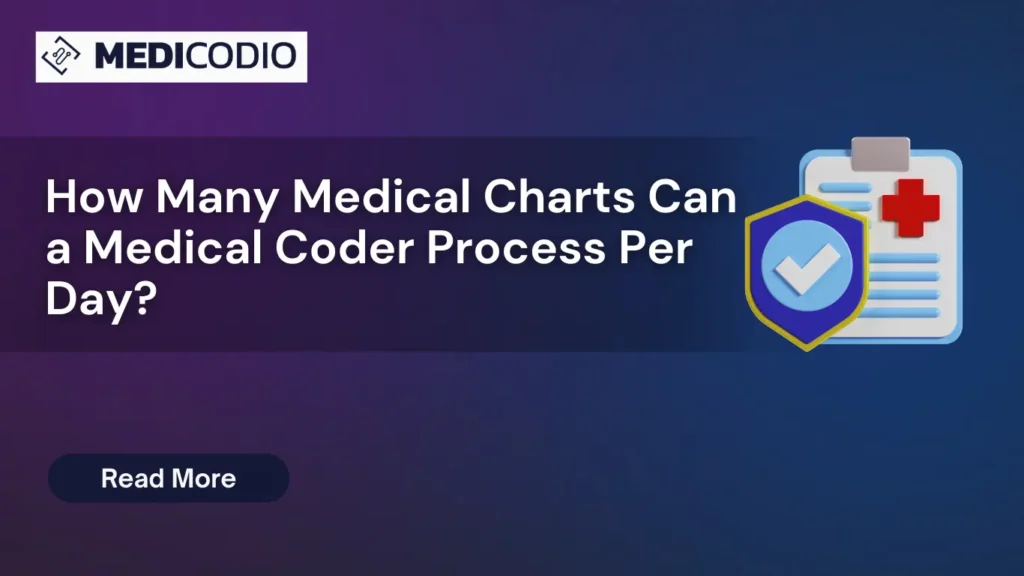Medical Coders are one of the valuable resources that play a crucial role in the healthcare organization’s RCM journey. Without medical coders, it is hard for healthcare facilities to manage medical charts and get reimbursed for the medical services they provide.
However, many aspiring medical coders and medical coding enthusiasts wonder how many medical charts a medical coder processes per day.
The answer to this question depends on multiple factors including the complexity of the chart, the specialty they work in, and more.
In this article, we’ll walk you through various factors that impact medical coders’ productivity, and the number of patients’ records a medical coder can process daily.
Factors Hindering Medical Coders’ Productivity
However, several factors can hinder their productivity, impacting both efficiency and accuracy. Here’s a breakdown of these challenges:
Complexity of Medical Charts:
-
- Illegible Documentation: Poor handwriting, unclear abbreviations, and inconsistent use of terminology by physicians can make deciphering medical records a time-consuming task. Coders need to spend extra time researching and clarifying information, slowing down the coding process.
-
- Incomplete Documentation: Missing information in charts forces coders to track down details, potentially delaying coding and requiring communication with physicians.
Coding System Challenges:
-
- Frequent Updates: Coding systems like ICD-10 and CPT undergo regular revisions to reflect new procedures, diagnoses, and guidelines. Staying updated requires ongoing education and adaptation, adding an extra burden on coders’ time.
-
- Complexity of Coding Systems: These systems can be intricate, with specific rules and guidelines for assigning codes. Coders need a deep understanding to navigate them effectively, potentially leading to slower processing for complex cases.
Workload and Time Constraints:
-
- High Volume: Medical coders often manage a large number of medical charts, leading to pressure to meet tight deadlines. This can compromise accuracy if they feel rushed to complete tasks.
-
- Coding Accuracy vs. Productivity: Striking a balance between speed and accuracy is a constant struggle. Rushing through charts can increase errors, requiring rework and potentially leading to claim denials.
External Factors:
-
- Inadequate Training and Resources: Insufficient training on coding systems and best practices can hinder efficiency. Additionally, lack of access to necessary resources, like reference materials or coding software, can slow down the process.
-
- Inefficient Workflow: Poorly designed workflows with unclear communication channels can lead to delays and rework. For instance, unclear communication between coders and physicians regarding chart discrepancies can create bottlenecks.
How Many Medical Charts Per Day?
The coding ability of medical coders may vary depending on the above factors. Typically, most of the coder’s code between 15 – 30 cases per hour, which comes down to 100-150 cases in a day within 8-hour shift.
The numbers also depend on the experience of the medical coders. If they have vast experience, they will be able to code more than newbies in less time. Experienced medical coders leave their newbie counterparts in the dust when it comes to coding volume. This advantage stems from a combination of factors. Firstly, veterans have a deeper understanding of complex coding systems like ICD-10 and CPT.
They’ve navigated the intricacies of these systems for years, allowing them to select the most accurate codes efficiently. Secondly, experience brings familiarity with medical terminology and procedures. Deciphering often-messy physician documentation becomes second nature, eliminating the need for newbies to spend extra time researching and clarifying information. Finally, seasoned coders have likely encountered a wider range of cases throughout their careers. This accumulated knowledge allows them to recognize patterns and apply their expertise quickly, leading to faster coding compared to less experienced colleagues.
Healthcare Setting Also Matter!
The number of medical charts a medical coder tackles depends heavily on the healthcare setting. Here’s why:
-
- Complexity of Cases: Settings like hospital inpatient coders might handle fewer medical charts daily compared to outpatient coders. However, inpatient cases are often more complex, involving multiple diagnoses, procedures, and consultations. Conversely, outpatient coders might deal with a higher volume of simpler cases from regular checkups.
-
- Documentation Volume: Doctors’ offices or clinics might have shorter, more streamlined documentation for routine visits. This allows coders to process more patient charts compared to settings with extensive documentation, like emergency departments or surgical units.
-
- Coding Specialization: Some facilities have coders specializing in specific areas like cardiology or oncology. These coders may handle fewer charts but achieve deeper efficiency within their specialized field.
-
- Workflow and Support: Work environments with efficient workflows and readily available resources like templates or coding software can significantly boost a coder’s output. Additionally, having quick access to physician clarification for unclear documentation can minimize delays.
For more information: check AAPC Forum!
How can AI improve Medical Coder’s Productivity?
The rise of Artificial Intelligence has paved the way for increased productivity, efficiency, and accuracy in medical coding.
AI can be a game-changer for medical coder productivity in several ways:
Automating Repetitive Tasks: AI-powered tools can automate many of the time-consuming, rule-based aspects of coding. For instance, AI can pre-populate certain codes based on keywords within the medical record, or suggest potential codes based on past coding decisions for similar cases. This frees up the coder’s time to focus on complex scenarios and tasks requiring human judgment.
Reducing Errors and Improving Accuracy: AI algorithms can analyze vast amounts of medical charts and coding guidelines to identify potential errors in real-time. This flags discrepancies or inconsistencies for coder review, minimizing the chance of mistakes that could lead to costly claim denials.
Faster Chart Review and Coding: AI can quickly scan and highlight relevant sections of a medical record, directing the coder’s attention to crucial details for assigning codes. This streamlines the review process, allowing coders to complete tasks more efficiently.
Learning and Adapting: Advanced AI systems can continuously learn from new data and coding decisions. Over time, this allows them to make increasingly accurate suggestions and automate tasks with even greater efficiency, further boosting coder productivity.
Focus on Value-added Tasks: By automating routine tasks and minimizing errors, AI empowers medical coders to dedicate more time to higher-level activities. This could involve analyzing coding trends for improvement, conducting audits, or focusing on complex cases requiring in-depth expertise.
Overall, AI integration acts as a powerful assistant, not a replacement, for medical coders. It automates tedious tasks, improves accuracy, and streamlines workflows, allowing coders to work faster and smarter, ultimately leading to significant productivity gains.
Have you tried CODIO?
One of the promising AI Medical Coding solution providers revolutionizing healthcare and RCM space is MediCodio.
MediCodio has designed CODIO to simplify the medical coding process. CODIO is a platform that uses deep learning and machine learning to suggest medical codes automatically. It reads patient information from EHR systems, physician notes, and charts to provide accurate codes. The platform has numerous features such as a CPT/ICD code search function, detailed dashboards, NCCI Edit checks, seamless API integrations, and automated data entry. By using CODIO, users can speed up the code selection process, reduce errors, claim denials, turnaround time, and expenses in medical coding processes. We have faith in the potential of AI and are committed to leveraging its power to help people overcome their challenges.





